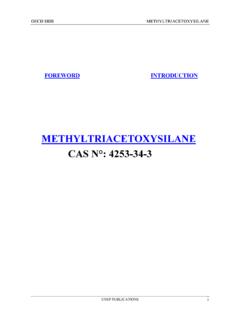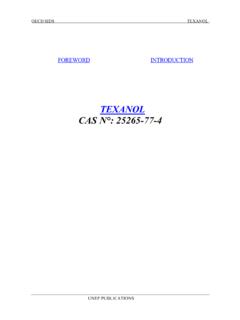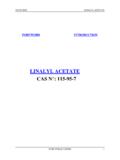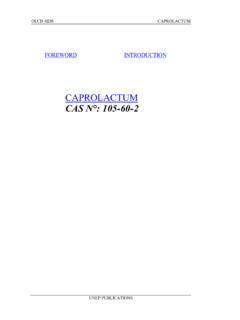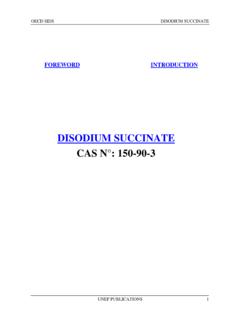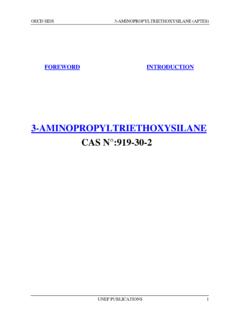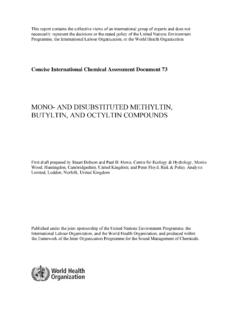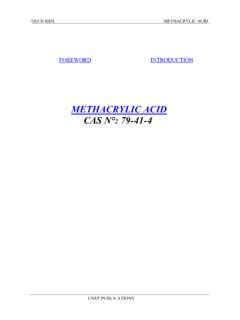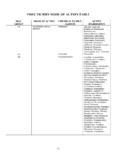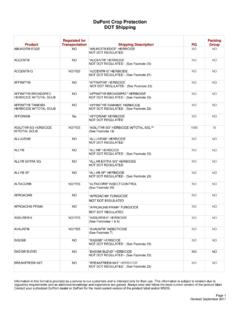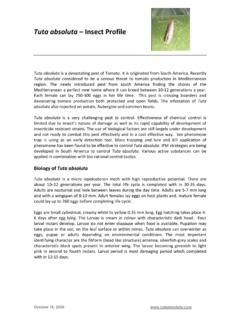Transcription of INDOXACARB - INCHEM
1 315 INDOXACARBF irst draft prepared byU. Mueller1 and Angelo Moretto21 Office of Chemical Safety, Therapeutic Goods Administration, Canberra, ACT, Australia; and 2 Dipartimento Medicina Ambientale e Sanit Pubblica, Universit di Padova, Padova, Italy 316 Evaluation for acceptable daily 316 Biochemical aspects .. 316 Absorption, distribution and 316 Biotransformation .. 319 Toxicological 319 Acute 319 Oral 319 Dermal administration .. 319 Exposure by inhalation .. 320 Dermal and ocular irritation .. 320 Dermal sensitization .. 320 Short-term studies of 323 Long-term studies of toxicity and 334 Reproductive 336 Multigeneration studies .. 336 Developmental toxicity .. 337 Special 338 Reversibility of haemolytic and body-weight changes. 338 Distribution of 14C-DPX-JW062 in rat erythrocytes .. 339 Haemolytic potential of N-hydroxy-4-(trifluoromethoxy)aniline (INMT713) in rats, dogs, and humans in vitro.
2 339 Haemolytic potential of IN-MT713 in vitro in erythrocytes from normal and glucose-6-phosphate dehydrogenase-deficient humans .. 341 Studies on the insecticidally-inactive enantiomer .. 342 Studies on insecticidally-active enantiomer .. 342 Studies with 347 Toxicological 349 References .. 352 INDOXACARB 31 3 JMPR 2005556316 Explanation INDOXACARB is the International Organization for Standardization (ISO) approved name for a new oxadiazine insecticide, methyl (S)-N-[7-chloro-2,3,4a,5-tetrahydro-4a-( methoxycarbonyl)-indeno[1,2-e][1,3,4]oxa diazin-2-ylcarbonyl]-4 -(trifluoromethoxy)carbanilate (the International Union of Pure and Applied Chemistry, IUPAC), also known as methyl (4aS)-7-chloro-2,5-dihydro-2-[[(methoxyc arbonyl)[4-(trifluoromethoxy)-phenyl]ami no]carbonyl]indeno[1,2-e][1,3,4]oxadiazi ne-4a(3H)-carboxylate (Chemical Abstracts Service, CAS).
3 The INDOXACARB racemate contains two enantiomers (S: R), designated DPX-KN128 and DPX-KN127, but only the S enantiomer has insecticidal activity. The ISO approved common name applies only to the insecticidally active S enantiomer. The INDOXACARB racemate DPX-JW062 has been used in several toxicological studies. Subsequent refinements in the chemical synthesis process have enabled commercial production of a mixture enriched approximately 3 : 1with the insecticidally active enantiomer. This enriched mixture has the code DPX-MP062 and is the active ingredient in all currently formulated products. The database contains a series of studies with DPX-MP062 to demonstrate its toxicological equivalence with DPX-JW062. INDOXACARB has not previously been considered by the Meeting. All pivotal studies were performed by good laboratory practice (GLP)-certified laboratories and complied with the relevant OECD test guidelines.
4 Evaluation for acceptable daily intake Unless otherwise stated, studies evaluated in this monograph were performed by GLP-certified laboratories and complied with the relevant OECD test guideline(s) or similar guidelines of the European Union or United States Environmental Protection Agency (EPA). As these guidelines specify the tissues normally examined and the clinical pathology tests normally performed, only significant exceptions to these guidelines are reported here, to save repetitive listing of study parameters. 1. Biochemical aspects Absorption, distribution and excretion The absorption, distribution, metabolism and excretion of DPX-JW062 (Himmelstein, 1997a) and DPX-MP062 (Himmelstein, 1997b) were evaluated in male and female Crl:CD(SD)BR (Sprague-Dawley) rats. The structure of DPX-JW062/DPX-MP062 and the location of the 14C radiolabels used in the studies of metabolism are shown in Figure 1.
5 Figure 1. Structure of DPX-MP062/DPX-JW062 and position of radiolabels + Indanone label * Trifluoromethoxyphenyl label 21112&O22)))22&+ &+ 2 INDOXACARB 31 3 JMPR 2005556 INDOXACARB 31 3 JMPR 2005317 Although only sparingly soluble in aqueous media ( g/ml), racemic INDOXACARB (DPX-JW062 or DPX-MP062) was suspended in polyethylene glycol (PEG-400) to give a fixed dosage volume of 10 ml/kg bw. The rats received INDOXACARB suspensions containing radiolabelled INDOXACARB at a dose of 5 or 150 mg/kg bw (15 40 Ci, 555 1480 MBq, per rat) by gavage. An additional group of female rats received 5 mg/kg bw per day for 14 days, to determine the potential for bioaccumulation. INDOXACARB was slowly absorbed from the gastrointestinal tract after administration of 5 mg/kg bw, but at 150 mg/kg bw it appeared that absorption was saturable despite the presence of an absorption enhancer (PEG-400).
6 Absorption in both sexes at 5 mg/kg bw was similar and estimated to be approximately 69 81% based on the radioactivity excreted in urine, bile and that found in tissues. At 150 mg/kg bw, the absorption was reduced to about 8 Biliary excretion was slightly greater in males (23%) than in females (17%) for both labels at 5 mg/kg bw, but was more pronounced at 150 mg/kg bw, and respectively. At 5 mg/kg bw, the Tmax in plasma was similar in males and females (males, 5 h; females, 8 h), while at 150 mg/kg bw the difference was greater (males, 3 h; females, 27 h). The elimination half-lives at 5 mg/kg bw were 35 h and 52 h for the indanone label and 92 h to 114 h for the trifluoromethoxyphenyl label in males and females respectively. At 150 mg/kg bw, the half-lives for the indanone label in both sexes were similar (45 59 h) while they were much longer for the trifluoromethoxyphenyl label ( 92 h and 114 h for males and females respectively), suggesting that some biotransformation of INDOXACARB had occurred and that the elimination of the resulting radiolabelled metabolite was slow.
7 An inspection of the distribution and retention profile of radioactivity in tissues 168 h after oral dosing suggested that most of the retained metabolites were lipophilic (see Table 1). The similarity of the tissue to plasma ratios for the two labels in fat, adrenals and ovaries suggests that the metabolites present in these organs are likely to be similar. In contrast, the tissue to plasma ratio was markedly different for the two labels in erythrocytes and therefore it seems likely that the metabolites would be different from those observed in fat, adrenals and ovaries. In both sexes, most of the radiolabel (85 100%) in fat was associated with the biologically more active metabolite (methyl 7-chloro-2,5-dihydro-2-[[[4-(trifluorome thoxy)phenyl]amino]-carbonyl] (IN-JT333), which is formed via hydrolysis of the carboxymethyl group from the amino Table 1.)
8 Tissue to plasma ratio of INDOXACARB in selected tissues of rats 168 h after administration of radiolabelled INDOXACARB as a single oral dose Tissue Indanone label Trifluoromethoxyphenyl label Male Female Male Female Enantiomer ratio (S : R)1:1 3:1 1:1 3:1 1:1 1:1 5 mg/kg bw Fat 11 31 29 63 16 32 Adrenals 3 7 5 16 9 5 Ovaries 3 10 3 Erythrocytes 2 4 2 2 123 61 150 mg/kg bw Fat 6 22 5 18 Adrenals 2 5 4 3 Ovaries
9 8 2 Erythrocytes 88 52 From Himmelstein (1997a) 556318nitrogen of the trifluoromethoxyphenyl moeity in the parent compound (see proposed metabolic pathway, Figure 2). Data from rat hepatic microsome preparations in vitro showed that while females metabolized INDOXACARB (5 mol/l) more slowly than did males ( t1/2 = and min respectively), almost tenfold more IN-JT333 was formed. These in vitro data support the observation made in vivo that females had a twofold greater body burden of IN-JT333 in fat than males (Himmelstein, 1997a). It was speculated that the metabolite that was selectively retained in erythrocytes and contributed to the long half-life of the trifluoromethoxyphenyl radiolabel involved only the trifluoromethoxyphenyl portion of the INDOXACARB molecule ( metabolite KB-687; see proposed metabolic pathway, Figure 2).
10 In a follow-up study, the metabolite was characterized as being a related metabolite, arylamine 4-trifluoromethoxyaniline (IN-P0036) (see section ; Anderson, 1999). The distribution of radioactivity for rats given INDOXACARB with an indanone label as a single oral dose at 5 mg/kg bw was: urine, 37 41%; faeces, 44%; and tissues, For rats given INDOXACARB with a trifluoromethoxyphenyl label as a single oral dose at 5 mg/kg bw, the distribution of radioactivity was: urine, 47 55%; faeces, 27 30%; and tissues, 10 17%. Females retained more tissue residues than did males (Table 1). Chiral high-performance liquid chromatography (HPLC) analysis indicated that the active enantiomer of IN-JT333, namely IN-KN125, was preferentially retained in fat with the approximate ratio of 2 : 1. Additional support for stereospecific kinetics was from the observation that the ratio of active (IN-KN125) to inactive enantiomer (IN-KN124) was approximately 6 : 1 7 days after dosing with INDOXACARB (DPX-MP062) with an enantiomer ratio of 3:1 ( DPX-KN125 : DPX-KN124) at 5 mg/kg bw.
